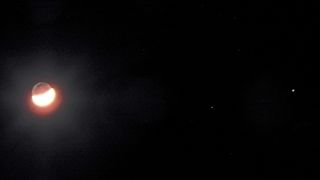Dim Planet Uranus Makes a Surprise Appearance in This Night Sky Photo

Can you spot Uranus in this photo?
What might look like a small speck of dust on your monitor is actually the third-largest planet in the solar system lurking nearly 1.9 billion miles (3.1 billion kilometers) away from Earth.
You may be surprised to learn that while Uranus is a dim and distant planet, it is possible to see it with the naked eye — no telescopes or binoculars required. All you need is a dark sky, a clear night and an idea of where to look for it.
Related: Photos of Uranus, the Tilted Giant Planet

"Uranus is a difficult target that I have only seen a couple of times in my 35 years of doing astrophotography," said Victor Rogus, an astrophotographer based in Sedona, Arizona.
After he discovered Uranus photobombing this conjunction of the moon and Mars on Feb. 10, he sent it to the Adler Planetarium in Chicago, where astronomers "confirmed that this is indeed [the] planet Uranus in my photo," he said.
At the time, Uranus was shining with an apparent magnitude of 5.8, which is just bright enough to detect with the unaided eye. However, skywatchers in light-polluted cities like New York will need to travel to a darker location to observe the planet.
Get the Space.com Newsletter
Breaking space news, the latest updates on rocket launches, skywatching events and more!
Although telescopes and binoculars are not required to see Uranus on a dark, clear night, binoculars can come in handy when you're trying to locate it — especially for those with less-than-stellar eyesight. Look for the planet in the constellation Aries in the evening sky this spring.
Rogus captured this view using a Nikon Coolpix P900 autofocus camera zoomed to 1,000 millimeters without the help of a telescope or a special zoom lens.
- When, Where and How to See the Planets in the 2019 Night Sky
- Hubble Telescope Watches the Weather on Uranus and Neptune
- Light Pollution Is a Big Problem, But You Can Help
Email Hanneke Weitering at hweitering@space.com or follow her @hannekescience. Follow us on Twitter @Spacedotcom and on Facebook.
Join our Space Forums to keep talking space on the latest missions, night sky and more! And if you have a news tip, correction or comment, let us know at: community@space.com.

Hanneke Weitering is a multimedia journalist in the Pacific Northwest reporting on the future of aviation at FutureFlight.aero and Aviation International News and was previously the Editor for Spaceflight and Astronomy news here at Space.com. As an editor with over 10 years of experience in science journalism she has previously written for Scholastic Classroom Magazines, MedPage Today and The Joint Institute for Computational Sciences at Oak Ridge National Laboratory. After studying physics at the University of Tennessee in her hometown of Knoxville, she earned her graduate degree in Science, Health and Environmental Reporting (SHERP) from New York University. Hanneke joined the Space.com team in 2016 as a staff writer and producer, covering topics including spaceflight and astronomy. She currently lives in Seattle, home of the Space Needle, with her cat and two snakes. In her spare time, Hanneke enjoys exploring the Rocky Mountains, basking in nature and looking for dark skies to gaze at the cosmos.
